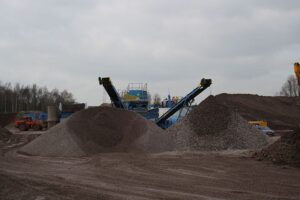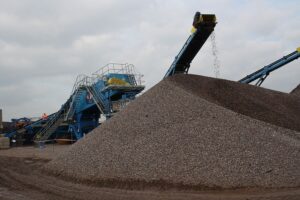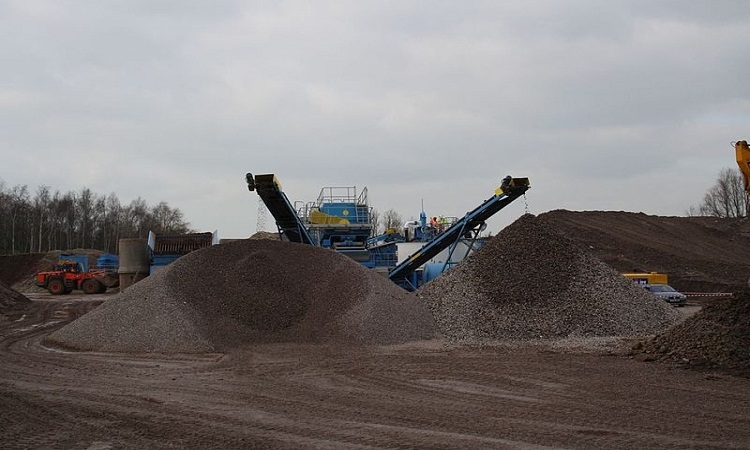History
Recycled concrete aggregates or Crushed concrete aggregates has been in use since the ancient times, only to be integrated with gravel, sand, and cement to ensure durability. The practice was first recorded in the 1860s. US construction companies were reluctant to use the technique at first since crushing cured concrete proved to be much more cost-intensive in terms of labor.
However, in the 1970s, when the construction era was at its peak, landfills refused to accept broke concrete, since it had no recyclability and took up too much space. One landfill, on the other hand, continued accepting concrete dumps, crushing it with the help of bulldozers and rollers, and reselling it as aggregate.
After a number of successful projects, construction companies confirmed that not only did recycled concrete offer equal strength and durability in new concrete. It also had a much lower impact on the environment.
With advancements in construction technology, Recycled concrete aggregate or Crushed concrete aggregate has been further developments, making it much more refined and cost-effective.
What are Recycled Concrete Aggregates?
Recycled concrete aggregates also called Crushed concrete aggregates are fragments and pieces of concrete buildings that are demolished or rebuild. This crushed concrete is cleaned from dirt and broken into smaller pieces to manufacture aggregate which is termed as Recycled Concrete Aggregate or Crushed concrete aggregate.
Recycled concrete aggregate or Crushed concrete aggregate eliminates the need for disposal by using the readily available concrete as an aggregate source for new concrete or other applications.

Recycled concrete aggregate or Crushed concrete aggregate is an aggregate made from used concrete from demolition sites. The quantity of old concrete from a demolition site depends on the type of building.
e.g. the list below shows the percentage of concrete for various building types.
Housing 47%
Leisure 50%
School 68%
The definition of recycled concrete aggregate is it contains less than 5% of other hard materials such as brick and contains no inert or organic materials.
Properties of Recycled Concrete Aggregates
Particle Size Distribution
The result of sieve analysis carried out as per IS 2386 for different types of recycled concrete aggregate and natural aggregates. It is found that recycled coarse aggregate is reduced to various sizes during the process of sieving and crushing, which gives best particle size distribution. The number of fine particles less than 4.75 mm sieve after recycling of demolished concrete. The best quality natural aggregate can obtain by primary, secondary, and tertiary crushing whereas the same can be obtained after primary and secondary crushing in the case of recycled aggregate. The single crushing process is also effective in the case of recycled concrete aggregate.
The particle shape analysis of recycled concrete aggregate indicates a similar particle shape of natural aggregate obtained from crushed rock. The recycled concrete aggregate generally meets all the standard requirements of aggregate used in concrete.
Water Absorption
Water absorption of recycled concrete aggregate is greater than of natural aggregate. It is one of the most significant properties that distinguish recycled concrete aggregate from raw aggregates. Water absorption of recycled aggregate influences both fresh and hardened concrete properties.
Specific Gravity
The specific gravity of recycled concrete aggregate was found from 2.35 to 2.58 which are lower as compared to natural aggregates. Since the recycled concrete aggregate demolished concrete consists of crushed stone aggregate with old mortar adhering to it.
Density
The density of recycled concrete aggregate is smaller than natural aggregate density.
Impact Value and Crushing Value
The recycled concrete aggregate is relatively weaker than the natural aggregate against mechanical actions. As per IS 2386, the impact and crushing value for concrete wearing surfaces should not exceed 50% and 45% respectively. The impact value and crushing value of recycled concrete aggregate satisfy the BIS specification except for the RCA2 type of recycled concrete aggregate for impact value as originally it is low-grade rubbles.
Los Angeles Abrasion Loss
Recycled concrete aggregate conforms with ASTM international with regard to Los Angeles abrasion loss.

Use of Recycled Concrete Aggregates
The use of recycled concrete aggregate is divided into two major groups:
Use of Recycled Concrete Aggregates (Unprocessed)
In general application without any processing includes:
- Many types of general bulk fill
- Bank protection
- Base or fill for drainage structures
- Road construction
- Noise barriers and embankments
Use of Recycled Concrete Aggregates (Processed)
After processing recycled concrete aggregate can be used in the following projects:
- Bridge foundations
- Structural grade concrete
- Lean-concrete
- Freeways
- Bituminous concrete
- Airport runways
- Pavements
- Shoulders
- Median barriers
- Sidewalks
- Curbs and gutters
- Soil-cement pavement bases
- Oil and gas civil construction projects
Influence of Recycled Concrete Aggregates on Concrete Properties
Flexural and Tensile Strength
ACI 55.1R reported that flexural and tensile strength of concrete made from recycled concrete aggregate is less than conventional concrete by 10% and this reduction increases to 20% in the worst-case scenario. However, concrete produced from coarse recycled concrete aggregate or crushed concrete aggregate and natural sand provides approximately the sametensile&flexuralstrength as concrete made from the natural aggregate.
The standard size of beams for flexural tests according to BS 1881 is 150mm X 150mm X 700mm.
Modulus of Elasticity
The modulus of elasticity of concrete made with recycled coarse & fine aggregate is lower than that of concrete made with a recycled coarse aggregate only.
Creep
The creep of concrete produced from recycled concrete aggregate is higher than concrete made using natural aggregate by 30% – 60%.
Drying Shrinkage
The drying shrinkage of concrete made from recycled concrete aggregate is usually greater than concrete made using natural aggregate. The percentage of drying shrinkage soars if it is produced from the recycled coarse and fine aggregate.
Reduction in Concrete Strength
By and large, the strength of concrete produced from recycled concrete aggregate is lower than concrete made using natural aggregate. The strength reduction of concrete produced from recycled coarse aggregate and natural fine aggregate ranges from 5% – 24%. This influenced by the strength of crushed concrete, water to cement ration of crushed and new concrete. For concrete produced from both recycled coarse and fine aggregate is between 15% – 40%.
Strength Variations
The strength variation of concrete produced from recycled concrete aggregate is higher than concrete made from the natural aggregate. For the recycled aggregate concrete, it would be necessary to add more cement quantity in concrete made with 100% of recycled aggregate in order to achieve the same workability and compression strength as conventional concrete.
Permeability
The permeability of concrete made from recycled aggregate or crushed concrete aggregate is greater than that of concrete produced with natural aggregate.
Freezing and Thawing Resistance
It is proven that the freezing and thawing resistance of concrete made with recycled concrete aggregate is the same as concrete production with natural aggregate.
Carbonation, Chloride Penetration and Reinforcement Corrosion
The carbonation of concrete made with recycled concrete aggregate is higher than concrete with natural aggregate, especially if the recycled aggregate suffered carbonation previously.
Similarly, the rate of reinforcement corrosion in concrete produced using recycled aggregate is higher than conventional concrete.
Shear Strength
The shear strength of recycled aggregate concrete is lower than of normal concrete. This is because the recycled aggregate from field-demolished concrete for example can be relative to natural aggregate. In general, there is a 10% decrease in strength when recycled coarse aggregate is used.
Advantages and Disadvantages of Recycled Concrete Aggregates
Advantages of Recycled Concrete Aggregates
There are many advantages to using recycled concrete aggregates.
Cost Saving
- Making use of recycled concrete aggregates over virgin materials can save money as they are less expensive to produce.
- If recycled materials are available locally then this can reduce the transportation cost of the aggregates.
- Producing recycled aggregate for resale is more cost-effective than sending un-wanted materials to landfill & incurring landfill tax.
Eco-friendly
- Recycled concrete aggregate or crushed concrete aggregate is regarded to be a “green” construction material
- Using recycled concrete aggregate reduces the number of virgin aggregates that are created and therefore means less use of natural resources.
- There is increasing pressure o landfill capacity and pressure on construction sites to divert waste away from landfills to meet sustainability targets.
Versatile
- Recycled aggregates can be used for various functions, suitable for use with construction projects, landscaping, and in-home improvement applications.
Durable
- Studies prove that recycled concrete aggregate is as structurally reliable as natural aggregate and is as safe to use.
Disadvantages of Recycled Concrete Aggregates
- The downgrading of the quality of concrete.
- Increase in water absorption capacity ranging from 3% to 9%.
- The decrease in the compressive strength of concrete.
- Reduces the workability of concrete.
- Lack of specification and guidelines.
- Brittle concrete might be mixed within the aggregate, leading to uneven grading.
- Visual inspection is necessary to ensure the mix is refined.

